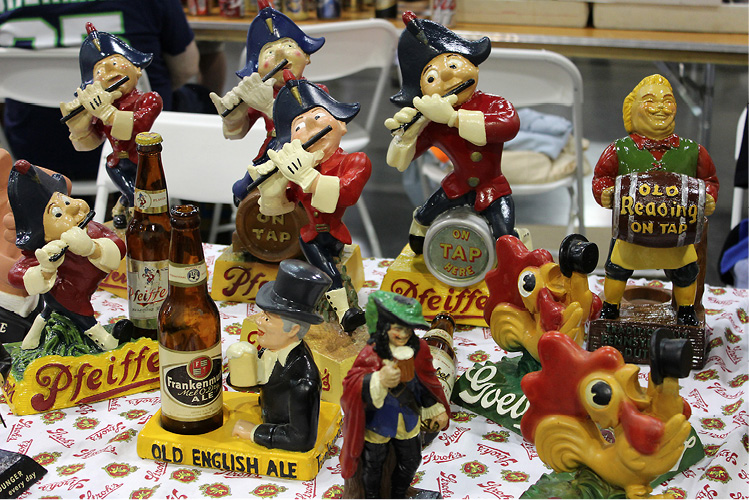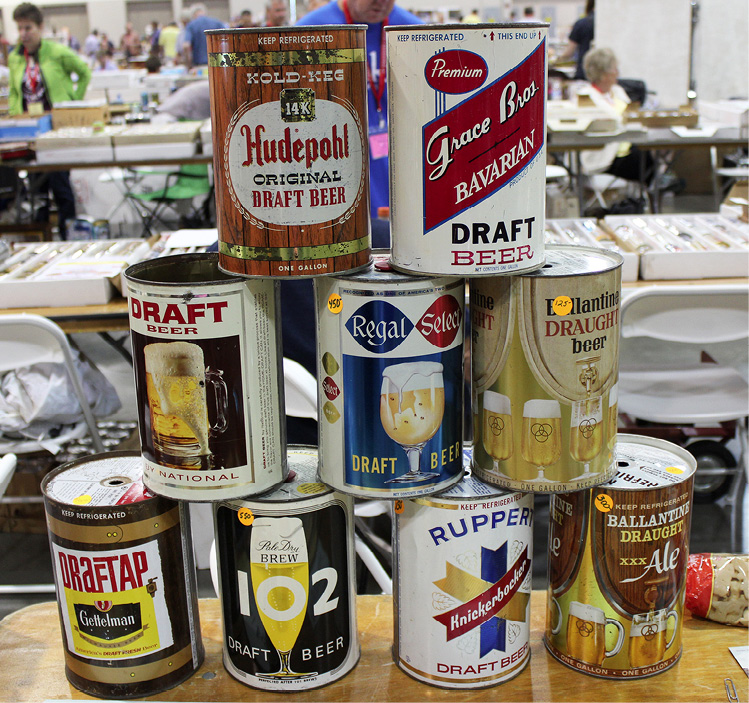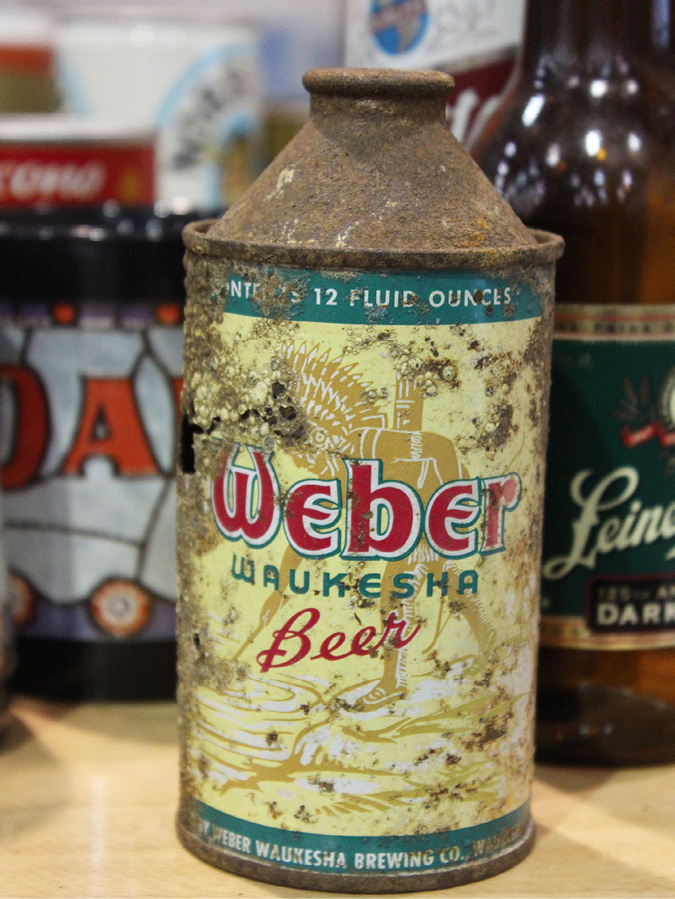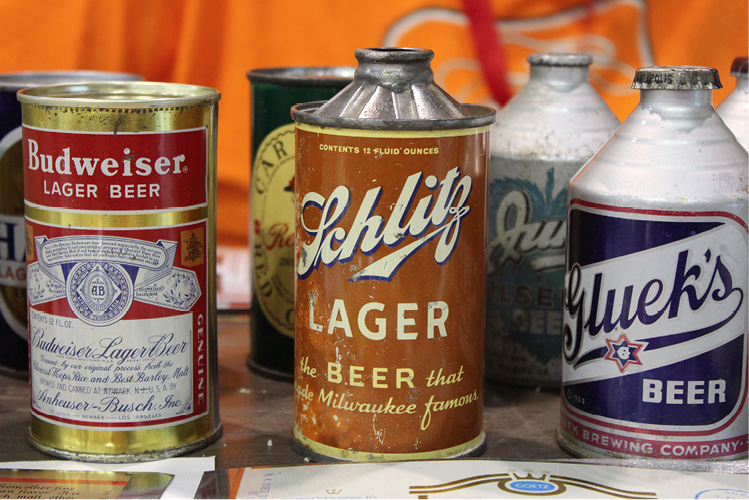24
Cans, Church Keys, and Vintage Signage
The Wonderful World of Breweriana
F or anyone passionate about beer, there’s no better gift than a bottle, can, or growler of their favorite beverage. However, such gratification is fleeting; it remains in one’s possession for only as long as it takes the possessor to drink it (unless it’s a style that benefits from aging and can be cellared).
That’s part of the reason why there’s an entire subculture of memorabilia collectors who focus exclusively on beer-related artifacts, items known throughout the beer world as “breweriana.”

Beer marketing tchotchkes were considerably more playful back in the day.
The largest collector collective in the breweriana realm is the Brewery Collectibles Club of America (BCCA), which boasts a history spanning more than four decades. There are now official chapters in thirty-six US states and four Canadian provinces. Overseas, Australia is home to two chapters, and Europe and Brazil each have one. If that doesn’t sound like a vast enough network, there also are twenty-nine “at-large” chapters, which are based around members who share a specific collecting interest.

The gallon-size flat-top keg can was a short-lived format in the mid- to late ’60s, but cans in good condition fetch hundreds of dollars among collectors.
The organization launched in 1972, and in 1975 it produced a first-of-its-kind comprehensive compendium of beer can history, the Guide to United States Beer Cans. Today, BCCA prints a bimonthly magazine called Beer Cans & Brewery Collectibles, a full-color glossy magazine that packs its typical forty-eight pages with features on brewery histories, specific cans, and niches within the broader breweriana collecting world.
According to BCCA, among the original collectibles were the metal crown caps, which first showed up on the tops of bottles in the late nineteenth century. The majority of these caps were branded with their particular brewery, most of which don’t even exist anymore.
The enactment of Prohibition in 1920 spurred a surge in collecting, as pretty much anything associated with the production, sale, and distribution of beer (and other alcoholic beverages) was rendered a relic.
Immediately after the repeal of Prohibition, before the newly legal beer was even cold, the next wave of collecting began in earnest.
While conducting research for a book on the subject, noted Connecticut-based breweriana and brewing history expert Jeff Browning got his hands on some old letters consumers had sent to breweries in 1934 asking for beer labels from their new products. Those likely came right from the presses, as the Twenty-first Amendment had just been enacted mere weeks prior. “The collecting gene seems to be prevalent in most of America, so I can’t imagine that people weren’t collecting prior to that,” notes Browning, whose own collection includes about 40,000 items.
Then, in 1935—barely two years into legalized brewing—another facet of breweriana collecting was born, though most didn’t even realize it at the time: beer cans and openers. (Beer was very likely finding its way into cans prior to Prohibition, as evidenced by the mention of both jars and cans of beer in old turn-of-the-twentieth-century blues songs. See the section on growlers for more on that blues connection.)
Browning has been an avid collector since the early to mid-’70s, a time when the hobby was expanding rapidly. Breweries, at the time, had really begun to forge significant marketing tie-in deals with sports teams, whose stars often appeared on cans—a novelty in those days. Artwork related to the approaching Bicentennial also found its way onto aluminum containers during that era.
It was also around that time that BCCA launched its annual collectors’ summit, CANvention, which continues today, offering three days of wall-to-wall memorabilia. The most recent edition was in one of the all-time classic beer cities, Milwaukee, which practically invented breweriana.

This vintage cone-top for the Weber brand has seen better days.
The rest of the year, collectors often spend their time going through antique shops with a fine-toothed comb, seeking hard-to-find, tucked-away items to feed their obsession. And, then, of course, there’s the Internet. One of the most significant buying/selling sites to help breweriana aficionados support their hobby is Breweriana.com, established in 1996 by lawyer Dan Morean. At the time, Breweriana.com was one of only two sites devoted to the hobby; the other has since folded, but many others emerged over the years.
So successful was Breweriana.com that Morean was able to leave his law career behind and focus full time on the site. In 2000, he opened a 5,000-square-foot brick-and-mortar operation in Brimfield, Massachusetts, housing four rooms jam-packed with cans and other memorabilia. Each well-appointed room of this veritable museum is arranged around a particular theme. The first is its flat-top showroom, which displays, as the name suggests, mostly flat-top beer cans and post-Prohibition ads. Then there’s the cone-top display room, which houses 500-square feet of those bottle-like aluminum cans. Next is its pre-Prohibition tavern room, which reproduces a late-nineteenth-century watering hole, complete with hickory floors, dark cherry molding, an antique mahogany bar and backbar, an 1880s pool table, and walls decked out in pre-Prohibition beer ads. Finally there’s the crowntainer/bottle showroom, which displays mostly glass packaging, as well as a few other types of containers. Visiting is by appointment only, but beer lovers living in or visiting New England (it’s about sixty-five miles outside of Boston) wouldn’t want to miss the opportunity to stroll through a century and a half of beer history.
Like most antique collectibles, breweriana can be an extremely expensive hobby, depending on how serious the collector wants to get about it. The old flat-top, church key-opened cans vary wildly in value, depending on the brewer, the age, the rarity, and just how sought-after an item they are in the collecting world. Breweriana.com’s online shop features modestly priced flat-tops, like an early 1950s-era Ballantine’s Export lager can that fetches about $20. On the opposite extreme, the site recently showcased a Rheingold Pale Double Bock can produced circa 1937 that was listed for a cool $7,000. Vintage signage, beer ad lithographs also can change hands for the mid-to-high four figures and low five figures.
But, in many cases, that’s chump change. Browning has seen single beer cans selling for as much as $30,000.
There’s a certain allure with late-nineteenth-century printed marketing materials. Back in those days, the uneducated and illiterate made up a much more significant percentage of the American population than it does today (hard to believe in this era of the Kardashians and their sort). Brewers needed to sell a lot of beer, regardless of how many of their prospective drinkers couldn’t even read or write. And they reached those consumers with very colorful ads; many couldn’t read the name of the brand, but they were able to identify its logo. “Little kids can’t read the name ‘Heinz,’ but they recognize the ketchup,” Browning explains.
“It’s basically pop art,” says Browning.
An Unconventional Lot
There are few scenes that are more of a feast for the eyes for those who fancy ancient packaging and marketing materials than the Beer Collectibles Club of America’s annual CANvention. The convention hall is a swap meet, a museum and Antiques Road Show rolled into one. It’s a sea of church key-opened flat-top, cone-top, and pull-tab cans, as well as ceramic brand statues, tin signs, clocks, bottle caps, wooden signs, and just about anything on which a brewery could imprint its label. Some of it dates back to the nineteenth century, but the surprising part is that some of it is remarkably new. For every dinged up cone-top of long-gone brands like Koller’s Topaz or Hanley’s Extra Pale, there are fresh-off-the-seamer aluminum containers of more recent entries into brewing’s hallowed halls, such as Abita, Sixpoint, and Oskar Blues. They’re empty but completely sealed, with their tabs completely untouched and intact. They may not be worth a ton now, but as any collector knows, today’s functional containers are tomorrow’s treasures. It helps to be a bit ahead of the curve.
Interestingly, some flat-top pull-tab cans from the mid-twentieth century—from brands that are virtually extinct, like Huber and Piels, to surviving and thriving ones like Budweiser and Miller—were priced at only a buck a can in some circles. Some were even going for five for a dollar. Rarity is only part of their valuation. Condition is a huge component. Collectors kept the cans in pretty good shape for forty-odd years, but they’re missing their pull tabs. (They were open and used at one point, obviously. Beer drinkers weren’t hanging on to those pull-off opening mechanisms. Back in those days, they were a major source of pollution).
The cone-tops are the Holy Grails for many collectors, but it’s really difficult to find any in a condition that’s anywhere approaching mint. More likely they’re dirty and rusted, with holes corroded into the sides and bottoms. But avid collectors are willing to part with five bucks for those.
Strolling table to table through the convention hall, one almost can piece together a visual timeline of nearly a century’s worth of packaging evolution. And while most containers evolve, some outright fail. There’s been a lot of trial-and-error involved in creating a format for multi-serve, take-home, draft-style beer, beyond purchasing a full- or half-size keg’s worth of beer, of course. In the mid- to late ’60s, brewers marketed tap-able gallon-size keg cans that looked like a much larger version of the classic flat-tops. After about four years on the market, packaging makers discontinued the gallons due to lack of interest. But there’s no shortage of interest in these now-rare receptacles at Canvention. It’s not uncommon to see some priced at $500 or $600.

Fairly well preserved flat-top and cone-top cans.
Buyers and sellers frequently get asked what motivates them. For many, it’s not necessarily about acquisition. A lot of times it’s about the hunt. And hunt they will—through antique shops, rummage sales, and even landfills. That latter activity is known as “dumping.” Armed with metal detectors, they’ll often uncover breweriana that’s been buried for decades.
Many continue with the hobby because of a strong emotional connection with the past, and usually it’s personal. A common story told at the Canvention among mid-to-late-middle-age collectors is how their parents would take them along on hunts and even to collectors’ conferences back in the ’70s. Years later their fond memories would lure them back into the hobby.
That’s what pulled Milwaukee collector Mark Navarre back into the breweriana world. He started orbiting rummage sales to find any cans he could. Eventually someone gave him a tip on a collection. He paid $700 for those three-thousand cans and never looked back.
“That’s how you make these connections,” he says. “One thing leads to another. You buy a big collection, keep ten percent of it for your own collection, and sell the rest.”
Now he regularly books a table at BCCA to do just that.